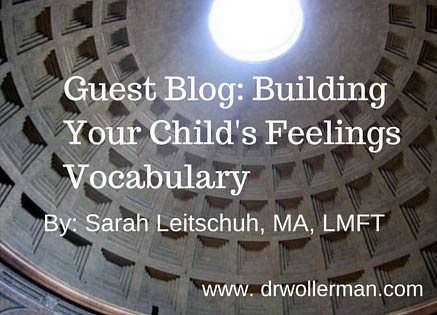Guest Blog: Building Your Child’s Feelings Vocabulary

I often talk to parents about being open to having their children express their emotions (feelings) through means other than words. Art, music and play are just a few of the powerful ways in which children communicate and share their emotions with us. I have learned so much about how children understand the world by just playing with them. Having said that, there are many reasons why it is valuable to help children build a feelings vocabulary and comfort in discussing their emotions.
The Benefits of Building Your Child’s Feelings Vocabulary
- When children are able to identify their emotions, they can more effectively ask for help when they are experiencing an overwhelming emotion.
- Being able to speak about their own emotions helps children in their relationships with others because they are better able to communicate and engage in conflict resolution.
- Being able to identify one’s own emotions is the first step in being able to develop empathy for others.
How Do We Help Children Build a Strong Feelings Vocabulary?
Short answer: We help children develop a feelings vocabulary by incorporating discussion about emotions into our daily interactions with them.
Longer Answer: (Including some ideas to try!)
We help children develop a feelings vocabulary by frequently exposing them to discussions of emotions. There are many ways that we can incorporate discussion of emotions into our daily interactions. Here are some possibilities to consider:
- Discuss emotions that you and your child experience though out the day. As adults, we should be thoughtful about what personal emotions we share with our children. It is important for children to learn that a range of emotions is normal, but we also do not want them to feel burdened.
- Reflect back on the day and have a feelings “check in” at dinner or bed time. Consider using a feelings chart or feelings wheel to help with the check in. There are many free varieties that can be found with a Google search and then you can choose the option that would most appeal to your child.
- Offer empathy for others. Help your child begin to understand the situations and emotions that others may be experiencing, again without burdening the child.
- Discuss the emotions that the characters in your child’s favorite book, game or television show may be experiencing.
- Read books specifically about emotions. Click here to link to a site that provides suggested reading material for children about challenging emotions and situations.
- Create activities based on your child’s interests that incorporates more directive exploration of emotions. For example, some children may enjoy playing “Feelings Charades” and others may enjoy creating a feelings book.
Do you have other ideas that you use to help children build their feelings vocabulary? If so, feel free to share your ideas in the comment section.

If you would like additional support or ideas to use in helping to build your child’s feelings vocabulary please feel free to contact me at sarah@sarahleitschuhcounseling.com.
Sarah Leitschuh is a Licensed Marriage and Family Therapist who practices in Eagan, Minnesota. Sarah provides therapy for children, adolescents and their families. Sarah has developed and offered a number of workshops for parents/caregivers. If you would like to learn more about the services that Sarah provides please visit www.sarahleitschuhcounseling.com.
Reach out to start
your healing journey

